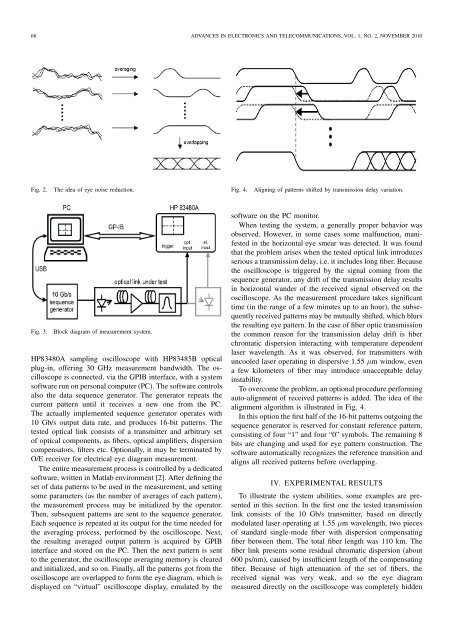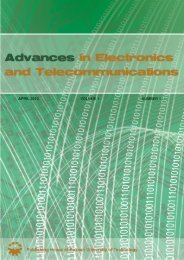november 2010 volume 1 number 2 - Advances in Electronics and ...
november 2010 volume 1 number 2 - Advances in Electronics and ...
november 2010 volume 1 number 2 - Advances in Electronics and ...
You also want an ePaper? Increase the reach of your titles
YUMPU automatically turns print PDFs into web optimized ePapers that Google loves.
68 ADVANCES IN ELECTRONICS AND TELECOMMUNICATIONS, VOL. 1, NO. 2, NOVEMBER <strong>2010</strong><br />
Fig. 2. The idea of eye noise reduction.<br />
Fig. 3. Block diagram of measurement system.<br />
HP83480A sampl<strong>in</strong>g oscilloscope with HP83485B optical<br />
plug-<strong>in</strong>, offer<strong>in</strong>g 30 GHz measurement b<strong>and</strong>width. The oscilloscope<br />
is connected, via the GPIB <strong>in</strong>terface, with a system<br />
softwarerunonpersonalcomputer(PC).Thesoftwarecontrols<br />
also the data sequence generator. The generator repeats the<br />
current pattern until it receives a new one from the PC.<br />
The actually implemented sequence generator operates with<br />
10 Gb/s output data rate, <strong>and</strong> produces 16-bit patterns. The<br />
tested optical l<strong>in</strong>k consists of a transmitter <strong>and</strong> arbitrary set<br />
of optical components, as fibers, optical amplifiers, dispersion<br />
compensators, filters etc. Optionally, it may be term<strong>in</strong>ated by<br />
O/E receiver for electrical eye diagram measurement.<br />
The entiremeasurementprocessiscontrolledbyadedicated<br />
software,written<strong>in</strong> Matlabenvironment[2].After def<strong>in</strong><strong>in</strong>gthe<br />
set of data patterns to be used <strong>in</strong> the measurement, <strong>and</strong> sett<strong>in</strong>g<br />
some parameters (as the <strong>number</strong> of averages of each pattern),<br />
the measurement process may be <strong>in</strong>itialized by the operator.<br />
Then, subsequent patterns are sent to the sequence generator.<br />
Each sequence is repeated at its output for the time needed for<br />
the averag<strong>in</strong>g process, performed by the oscilloscope. Next,<br />
the result<strong>in</strong>g averaged output pattern is acquired by GPIB<br />
<strong>in</strong>terface <strong>and</strong> stored on the PC. Then the next pattern is sent<br />
to the generator,the oscilloscope averag<strong>in</strong>g memory is cleared<br />
<strong>and</strong> <strong>in</strong>itialized, <strong>and</strong> so on. F<strong>in</strong>ally, all the patterns got from the<br />
oscilloscope are overlapped to form the eye diagram, which is<br />
displayed on “virtual” oscilloscope display, emulated by the<br />
Fig. 4. Align<strong>in</strong>g of patterns shifted by transmission delay variation.<br />
software on the PC monitor.<br />
When test<strong>in</strong>g the system, a generally proper behavior was<br />
observed. However, <strong>in</strong> some cases some malfunction, manifested<br />
<strong>in</strong> the horizontal eye smear was detected. It was found<br />
that the problem arises when the tested optical l<strong>in</strong>k <strong>in</strong>troduces<br />
seriousatransmissiondelay,i.e.it <strong>in</strong>cludeslongfiber. Because<br />
the oscilloscope is triggered by the signal com<strong>in</strong>g from the<br />
sequence generator, any drift of the transmission delay results<br />
<strong>in</strong> horizontal w<strong>and</strong>er of the received signal observed on the<br />
oscilloscope. As the measurement procedure takes significant<br />
time (<strong>in</strong> the range of a few m<strong>in</strong>utes up to an hour), the subsequentlyreceivedpatternsmaybemutuallyshifted,whichblurs<br />
the result<strong>in</strong>geyepattern.In the case offiber optictransmission<br />
the common reason for the transmission delay drift is fiber<br />
chromatic dispersion <strong>in</strong>teract<strong>in</strong>g with temperature dependent<br />
laser wavelength. As it was observed, for transmitters with<br />
uncooled laser operat<strong>in</strong>g <strong>in</strong> dispersive 1.55 µm w<strong>in</strong>dow, even<br />
a few kilometers of fiber may <strong>in</strong>troduce unacceptable delay<br />
<strong>in</strong>stability.<br />
Toovercometheproblem,anoptionalprocedureperform<strong>in</strong>g<br />
auto-alignment of received patterns is added. The idea of the<br />
alignment algorithm is illustrated <strong>in</strong> Fig. 4.<br />
Inthisoptionthefirsthalfofthe16-bitpatternsoutgo<strong>in</strong>gthe<br />
sequence generator is reserved for constant reference pattern,<br />
consist<strong>in</strong>g of four “1” <strong>and</strong> four “0” symbols. The rema<strong>in</strong><strong>in</strong>g 8<br />
bits are chang<strong>in</strong>g <strong>and</strong> used for eye pattern construction. The<br />
software automatically recognizes the reference transition <strong>and</strong><br />
aligns all received patterns before overlapp<strong>in</strong>g.<br />
IV. EXPERIMENTAL RESULTS<br />
To illustrate the system abilities, some examples are presented<br />
<strong>in</strong> this section. In the first one the tested transmission<br />
l<strong>in</strong>k consists of the 10 Gb/s transmitter, based on directly<br />
modulated laser operat<strong>in</strong>g at 1.55 µm wavelength, two pieces<br />
of st<strong>and</strong>ard s<strong>in</strong>gle-mode fiber with dispersion compensat<strong>in</strong>g<br />
fiber between them. The total fiber length was 110 km. The<br />
fiber l<strong>in</strong>k presents some residual chromatic dispersion (about<br />
600 ps/nm), caused by <strong>in</strong>sufficient length of the compensat<strong>in</strong>g<br />
fiber. Because of high attenuation of the set of fibers, the<br />
received signal was very weak, <strong>and</strong> so the eye diagram<br />
measured directly on the oscilloscope was completely hidden







